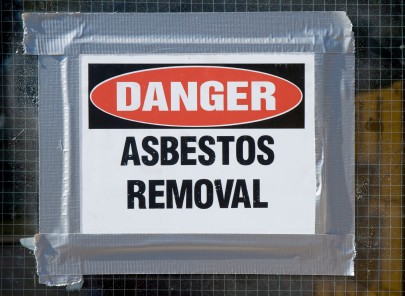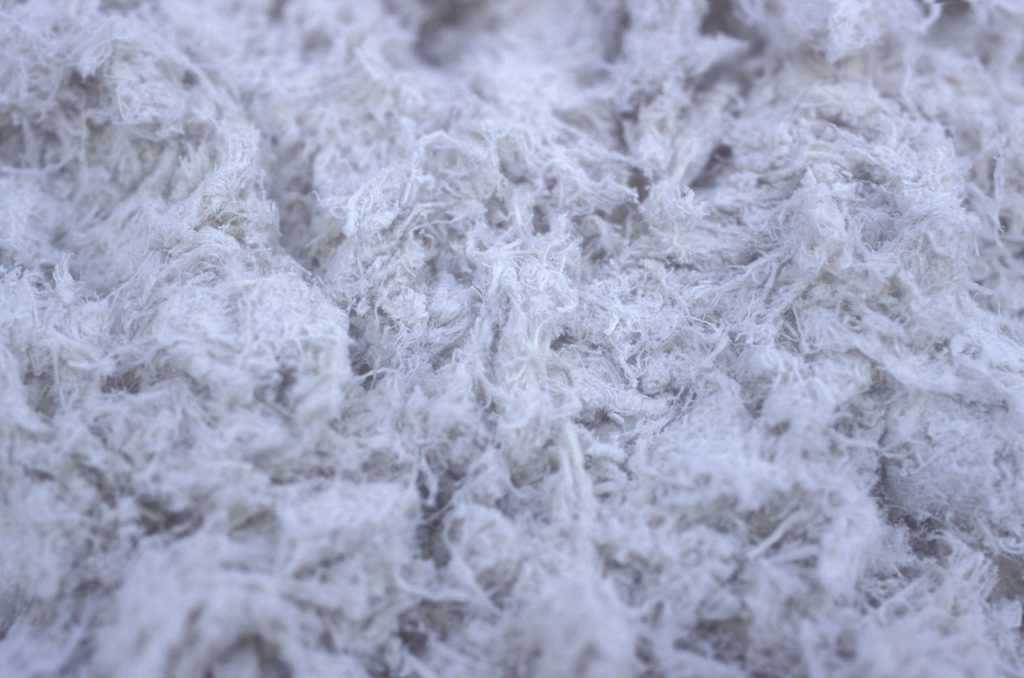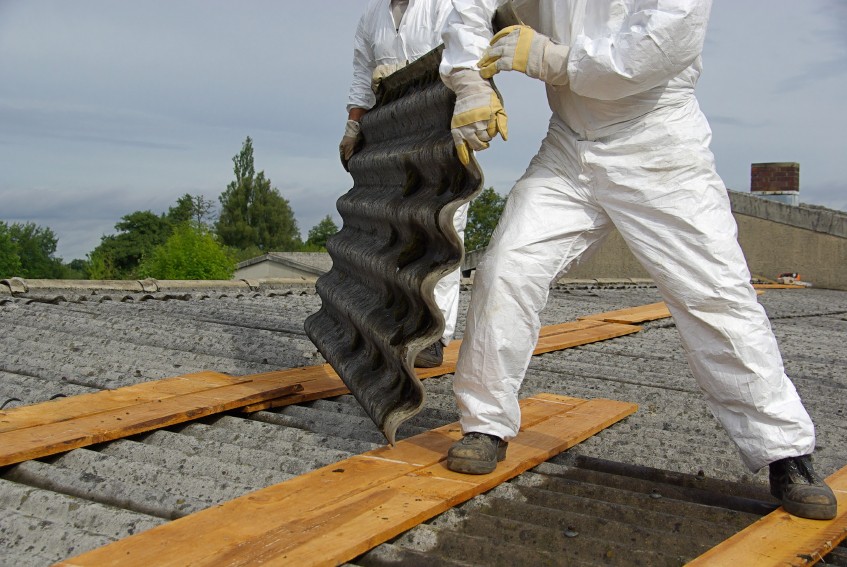Disposing of Asbestos Safely – A Guide
All asbestos use was banned in 1999, both for commercial and domestic purposes, which is why it can still be found in many structures (built before 1999) throughout the country. There are strict rules in place to prevent the use of asbestos, particularly in commercial premises, as a result of the Control of Asbestos Regulations 2012.
If asbestos is found in your house or place of work, it should be professionally removed immediately to protect those occupying the building. An unqualified, untrained individual should never remove and dispose of asbestos themselves – especially since it is illegal if you own a commercial property.

What is asbestos?
Asbestos is a harmful, hazardous substance which is made up of many microscopic fibres and it’s important to note that asbestos (of any kind) should not be touched or disturbed, unless being removed by a qualified professional.There are three types of asbestos that can pose a considerable threat to our health, these include:
White asbestos – also known as Chrysotile, this is the most common type of asbestos and contains exceptionally small amounts of tremolite. White asbestos is often finely textured, easy to manipulate and incredibly heat resistant.
Commonly found in:
- Cement
- Brake pads
- Brake linings
- Roofing materials

Brown asbestos – also referred to as Amosite, brown asbestos used to be mined in Africa. It’s a remarkably strong type of asbestos with impressive heat-resistant properties. Despite all types of asbestos being toxic, exposure to brown asbestos can pose a high risk of cancer.
Commonly found in:
- Cement sheet
- Electrical insulation
- Plumbing insulation
Blue asbestos – Crocidolite, as it’s also known, is comprised of extraordinarily thin fibres which, when inhaled into our system, can become lodged in our lungs. Due to its frailty and brittleness, blue asbestos has the ability to break down relatively easily, making it one of the most hazardous types of asbestos.
Commonly found in:
- Steam engine parts
- Spray-on coatings
- Pipe insulation
- Cement wallboard
Why is asbestos dangerous?
Due to its ability to break down into thin, microscopic fibres, asbestos can be incredibly dangerous when we’re exposed to it. These tiny fibres are able to stay airborne for several hours, or even days after they’ve been disturbed. Once they’re airborne, a person would have no trouble breathing those harmful fibres in. Due to their size, these fibres can travel into our lungs, therefore lodging themselves into our lung tissue. If this happens, a serious disease could be contracted, such as:
- Lung cancer
- Mesothelioma (a form of cancer which affects the lining of the lung cavity)
- Asbestosis (lung tissue scarring)
When is asbestos dangerous?
- When it has been touched
- When it’s being removed
- After it has been removed (fibres can remain airborne for a considerable time)
- When it has been inhaled or ingested
How do I know that I’ve found asbestos?
The only way to tell if you have found asbestos is by looking at it. There aren’t any physical, obvious signs that you have asbestos within your building. Despite common misconceptions, asbestos will:
- Give no clear sign that it has infected your lungs
- Not make you cough or sneeze
- Not make your throat sore or itchy
Asbestos fibres will only be released into the air when disturbed, damaged or removed using unsafe methods. Asbestos, when crushed, will not produce dust of an ordinary colour or texture, instead it will break down into many tiny fibres which cannot be seen or felt. This is when asbestos is in its most dangerous state.
There are several ways you can find out whether or not something contains asbestos, including:
Find out how old the material is
Depending on the item, you should be able to check the product name and manufacturer of the material – particularly insulation. Once you’ve acquired the aforementioned information, search for it on the internet to see whether it’ll contain asbestos.
The age of a structure or building material will usually indicate whether or not asbestos has been used. Generally, buildings constructed between the 1940’s and 1980’s are most likely to contain asbestos.
Inspect joints
The way the sheets have been held together could indicate that materials containing asbestos have been used. For the exterior of a building, you’ll typically find that asbestos sheets are joined together using aluminium runners which have been fixed using nails which are small in size and have blunt ends.
For the interior of a building, asbestos sheets are joined together using wooden or plastic runners, as opposed to aluminium ones. You should also pay particular attention to the use of adhesives, as opposed to runners, because they can contain asbestos as well.
Check surface patterns carefully
Materials containing asbestos will often have a texture to them, usually in the form of small, shallow craters or a number of tiny dimples.This isn’t a definitive way of testing for asbestos material, so you should take particular care, or call a professional for their opinion.
Analyse interior panels (where possible)
An older building will often have asbestos contained within walls, ceilings and floors. Therefore, you should look out for floor tiles which have a greasy, shiny or oily appearance – indicating that they’re made from asphalt which has been mixed and bound with asbestos.
Generally, decorative wall plasters (such as artex) and vinyl tiles will contain asbestos. Blow-in asbestos was also incredibly popular for use in ceilings above drywall and ceiling tiles – it’s typically off-white or grey in colour.
Investigate finishing materials
Asbestos wasn’t just used in construction materials which make up the bones of your building. It was also used in the manufacturing of other parts, including (but not limited to):
- Insulation
- Duct work
- Fireproof materials
- Eaves
- Flues
- Window putty
- Pipes
- Carpet underlay
If you’re still unsure about whether or not your property contains asbestos, call a professional to come and inspect the area. Some companies will offer full site surveys, whereas others are more suited to identifying specific, localised areas.

Can I just take asbestos to the tip myself?
This is an option in theory, but only for domestic homeowners. You must also check with your local council as to whether or not they will allow you to bring asbestos – a highly hazardous and toxic material – to the tip yourself. However, this is something which we do not recommend under any circumstances. Instead, call Woodford Recycling to dispose of asbestos for you.
If you own a commercial business, you cannot remove asbestos and then take it to the tip yourself – you must have a professional come in to survey the area and remove the material first. Once this has happened, it can then be collected and disposed of by a licensed waste carrier for safe and responsible disposal. This is a service we offer to both domestic and commercial customers here at Woodford Recycling.
How can I get rid of asbestos?
A professional asbestos removal company will need to identify and then remove the asbestos themselves. This is the safest, most responsible way of ridding your property of the dangerous material. Once this has been done, get in touch with Woodford Recycling for the disposal of your hazardous waste.
All of our specialists are highly-trained in the handling and disposal of asbestos, holding all necessary permits to carry out the job in a safe and efficient manner and to full health and safety standards.
We even provide dedicated asbestos containers of various sizes, so no job is too big for our team. Once it has all been loaded into our asbestos waste disposal unit, you’ll be supplied with the relevant paperwork, giving you peace of mind that your asbestos disposal will be tracked, approved and documented before we take any asbestos waste off site.
The disposal of asbestos follows strict rules and guidelines, ensuring its impact on the environment, and the threat it poses to the health of the general public, is kept to an absolute minimum.
Woodford Recycling is dedicated to the safe and responsible disposal of hazardous waste. If you live in Cambridge, Peterborough, Huntingdom, Stamford, St Ives or the surrounding areas, and are in need of efficient asbestos waste disposal, then get in touch with us today – we’re always happy to help.

